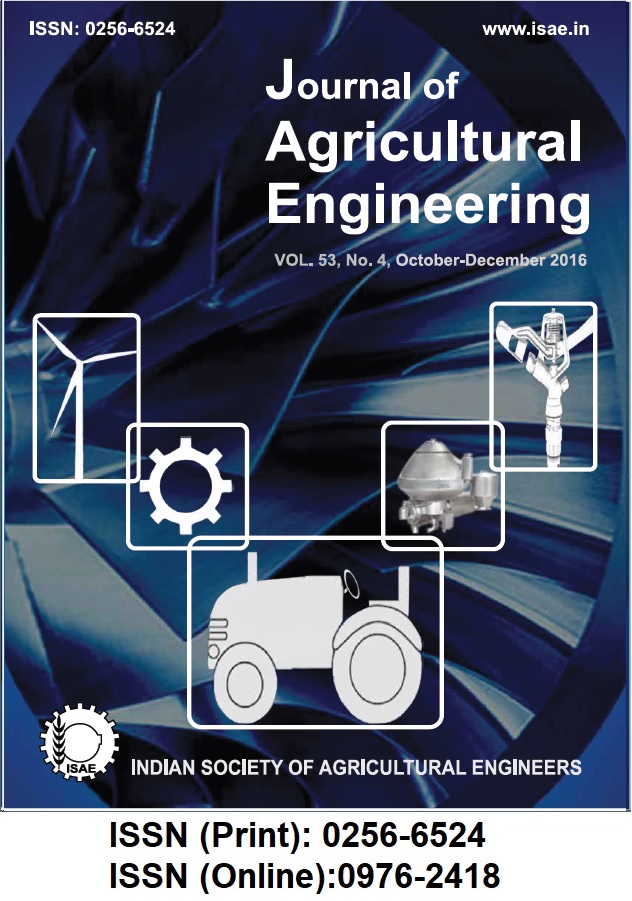An Interactive Multi-Objective Linear Programming Approach for Watershed Planning-A Case Study
DOI:
https://doi.org/10.52151/jae2016534.1613Keywords:
Cropping intensity, interactive technique, linear programming, multi objective, runoff, watershedAbstract
Agriculture is an economic activity that significantly contributes to the GDP of the country, and secures the viability of the rural sector and the social coherence. Optimal utilisation of available resources is important to meet the growing demand of food and fibres of the people. Watershed management planning study on the Badabandha Nala watershed in Banapur block of Khurda district, Odisha, was carried out using multi-objective programming approach and analysed with interactive technique (STEP method). A compromise solution was obtained from the optimal solutions by the preference of Decision Maker by using interactive step method. The land allocation plan was done considering the major crops grown in the area. The objective function was to maximise food, fodder, fuel wood, net income, labour employment generation and runoff water augmentation; considering constraints of land, water and human resources. The benefit-cost ratio of the proposed plan was 1.42:1 with cropping intensity of 170% (kharif 91%, and rabi 79%). The benefit for the proposed planning was 184% higher than the existing practices.
References
Anon. 2009. Orissa Agricultural Statistics. Department of Agriculture, Government of Odisha, pp: 125.
Beura P K. 1998. Multi objective approach in optimum land and water resources planning for Mahanadi delta command. Unpublished M. Tech. Thesis, OUAT,
Bhubaneswar.
Gadge S B; Gorantiwar S D; Kumar V; Kothari M. 2011. Optimal cropping pattern for adoption of microirrigation methods in canal command area-a case study.
J. Agric. Eng., 48 (1), 1-11.
Honghai Q; Altinakar M S. 2013. Integrated watershed management with multi-objective land use optimizations under uncertainty. J. Irrig. Drain. Eng., ASCE, 139 (3), 239-245.
Hu Yao; Cai X; Du P B. 2014. Design of a web based for the coupled multi agent system model and environmental model for watershed model analysis using Hadoop. J. Environ. Model. Software, 70, 149-162.
Jha M M; Singh R. 2008. Crop and irrigation planning of Kosi irrigation system. J. Indian Water Resour. Soc.,28(3), 30-38.
Latinopoulos D; Mylopoulos Y. 2005. Optimal allocation of land and water resources irrigated agriculture by means of goal programming: application in Laudious river basin. Global NEST J., 7 (3), 264-273.
Mangaraj B K; Tripathy P K; Rao K A; Sinha S B. 1985. Fuzzy technique to agricultural planning. In:Proc. of 18th Annual Convention of Operation Research Society of India, Jamshedpur, India, 63-67.
Mohan S; Jothiprakash V. 2000. Fuzzy system modeling for optimal crop planning. J. Inst. Eng. (India), CE, 81 (3), 9-17.
Naik B S. 2016. Optimal land and water use planning for Koraput district in estern ghat region of Odisha. Unpublished Ph.D. Thesis, OUAT, Bhubaneswar.
Paul J C; Mishra S B; Dhal G C. 2004. Multi objective programming approach for watershed planning- A case study. J. Soil Water Conserv., 3(1&2), 73-79.
Rejani R; Panda S N; Jha M; Mull R. 2011. Optimal cropping and ground water management in coastal basin. J. Indian Water Resour. Soc., 31(1), 19-35.
Sahu R K. 2015. An interactive multi-objective linear programming approach to watershed planning – a case study. Unpublished M. Tech. Thesis, OUAT, Bhubaneswar.
Salokhe V M; Raheman H. 1989. Optimum utilization of land and water for Bhargabi delta, India. J. Agric. Eng., 26 (3), 229-240.
Shirgure P S. 1998. An interactive multi objective linear programming approach to watershed planning: A case study. Indian J. Soil Cons., 26 (3), 258-263.
Singh J P; Sekar I; Rao K H V. 2012. RS and GIS for identification of potential sites for water harvesting structures in Bandal watershed. J. Agric. Eng., 49 (3), 41-43.
Wang L; Meng W; Guo H; Zhang Z; Liu Y; Fan Y. 2006. An interval fuzzy multi objective watershed management model for the lake Qionghai watershed, China. Water Resour. Manage., 20, 701-721.














